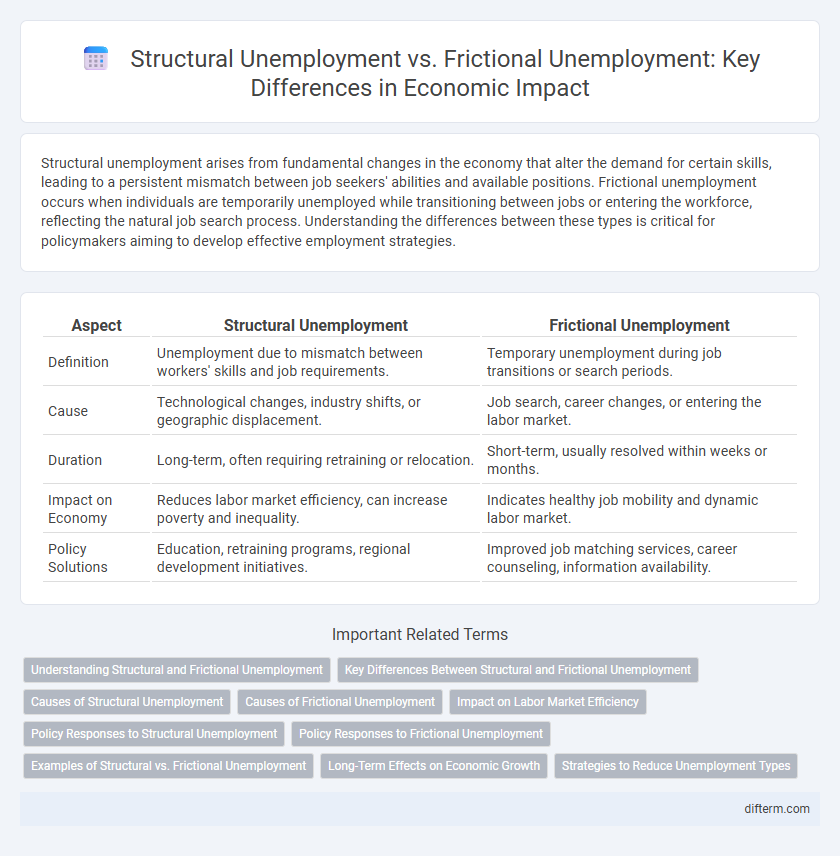Structural unemployment arises from fundamental changes in the economy that alter the demand for certain skills, leading to a persistent mismatch between job seekers' abilities and available positions. Frictional unemployment occurs when individuals are temporarily unemployed while transitioning between jobs or entering the workforce, reflecting the natural job search process. Understanding the differences between these types is critical for policymakers aiming to develop effective employment strategies.
Table of Comparison
| Aspect | Structural Unemployment | Frictional Unemployment |
|---|---|---|
| Definition | Unemployment due to mismatch between workers' skills and job requirements. | Temporary unemployment during job transitions or search periods. |
| Cause | Technological changes, industry shifts, or geographic displacement. | Job search, career changes, or entering the labor market. |
| Duration | Long-term, often requiring retraining or relocation. | Short-term, usually resolved within weeks or months. |
| Impact on Economy | Reduces labor market efficiency, can increase poverty and inequality. | Indicates healthy job mobility and dynamic labor market. |
| Policy Solutions | Education, retraining programs, regional development initiatives. | Improved job matching services, career counseling, information availability. |
Understanding Structural and Frictional Unemployment
Structural unemployment arises from fundamental shifts in the economy, such as technological advancements or changes in consumer demand, which render certain skills obsolete and create a mismatch between workers and jobs. Frictional unemployment occurs during the temporary period when workers are transitioning between jobs, often due to voluntary job changes or new entrants to the labor market. Understanding these types helps policymakers design targeted interventions, like retraining programs for structural unemployment and improved job matching services to reduce frictional unemployment durations.
Key Differences Between Structural and Frictional Unemployment
Structural unemployment results from fundamental shifts in the economy, such as technological advancements or changes in consumer demand, leading to a mismatch between workers' skills and job requirements. Frictional unemployment occurs due to the natural job search process, where workers transition between jobs or enter the labor force for the first time. Key differences include duration--structural unemployment tends to be long-term, while frictional unemployment is typically short-term--and causes, with structural rooted in economic changes and frictional linked to job mobility.
Causes of Structural Unemployment
Structural unemployment arises primarily from long-term shifts in the economy, such as technological advancements that render certain skills obsolete and changes in consumer demand that alter industry compositions. Geographic mismatches between job locations and worker residences contribute significantly, as workers may lack the resources or willingness to relocate for new opportunities. Additionally, inadequate education or training systems fail to equip labor forces with relevant skills, exacerbating the persistence of structural unemployment.
Causes of Frictional Unemployment
Frictional unemployment arises primarily from the time lag involved when workers transition between jobs, reflecting voluntary job changes, new entrants into the labor market, or individuals returning after a break. Key causes include imperfect information about job vacancies and worker qualifications, geographic mobility constraints, and mismatches in timing between job availability and job-seeker readiness. Unlike structural unemployment, frictional unemployment is often short-term and influenced by dynamic labor market conditions rather than fundamental shifts in the economy's structure.
Impact on Labor Market Efficiency
Structural unemployment reduces labor market efficiency by causing a mismatch between workers' skills and job requirements, leading to prolonged job vacancies and increased training costs. Frictional unemployment reflects short-term job transitions, maintaining market flexibility as workers seek better matches, thereby supporting efficient allocation of labor. High levels of structural unemployment indicate deeper economic issues that hinder labor mobility and overall productivity.
Policy Responses to Structural Unemployment
Policy responses to structural unemployment focus on enhancing workforce skills through comprehensive retraining programs and promoting labor market flexibility by incentivizing geographic mobility. Governments implement targeted education reforms and invest in technology-driven training to align worker capabilities with evolving industry demands. Supportive measures include subsidies for firms adopting automation and partnerships with private sectors to create employment opportunities in emerging fields.
Policy Responses to Frictional Unemployment
Policy responses to frictional unemployment prioritize improving job matching efficiency through enhanced labor market information systems, career counseling, and job placement services. Governments often invest in skill development programs and unemployment benefits that encourage job search without disincentivizing employment. These targeted interventions reduce time spent between jobs, fostering smoother transitions and optimizing overall labor market functionality.
Examples of Structural vs. Frictional Unemployment
Structural unemployment occurs when workers' skills no longer match job requirements, such as coal miners losing jobs due to shifts toward renewable energy, while frictional unemployment involves short-term job transitions, like a recent college graduate searching for their first position. Automation displacing manufacturing workers exemplifies structural unemployment, whereas workers quitting for better opportunities illustrate frictional unemployment. These distinctions highlight the need for retraining programs to address structural issues and efficient job matching services to reduce frictional unemployment.
Long-Term Effects on Economic Growth
Structural unemployment erodes long-term economic growth by creating persistent labor market mismatches that reduce overall productivity and innovation capacity. Frictional unemployment, while temporary, allows for efficient job matching, which supports dynamic labor markets and gradual economic adaptation. Prolonged structural unemployment leads to skill atrophy and lower human capital, causing sustained decreases in GDP growth potential.
Strategies to Reduce Unemployment Types
Structural unemployment can be reduced through targeted job training programs that align worker skills with evolving industry demands, while frictional unemployment decreases with improved job matching technologies and enhanced labor market information systems. Investment in education and continuous skill development fosters adaptability, addressing structural mismatches, whereas streamlined recruitment processes and better career counseling shorten job search durations for frictional unemployment. Policymakers should promote labor mobility and incentives for reskilling to effectively minimize both structural and frictional unemployment rates.
structural unemployment vs frictional unemployment Infographic

 difterm.com
difterm.com